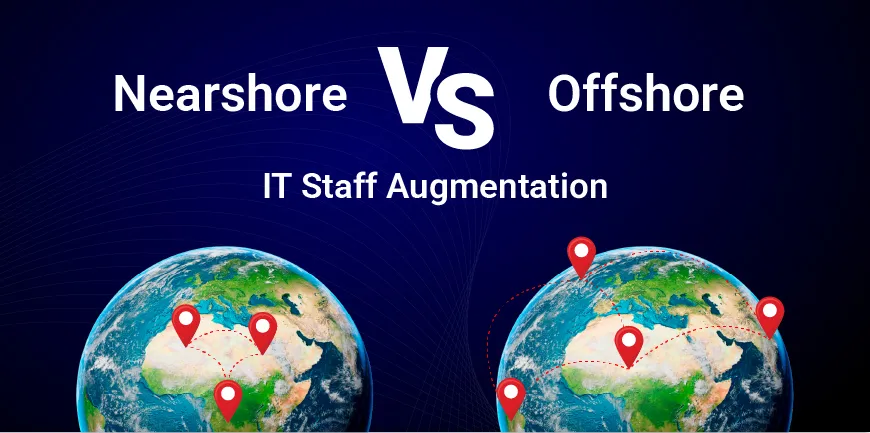
15 Effective Leadership Lessons Every Leader Must Know
24/10/2025
What Is Competency Mapping? Methods and Why It Matters in 2025
27/10/2025- What is IT Staff Augmentation?
- Understanding Nearshore IT Staff Augmentation
- Understanding Offshore IT Staff Augmentation
- Nearshore vs. Offshore IT Staff Augmentation: Key Differences
- What are the Benefits Comparison: Nearshore vs. Offshore?
- Factors to Consider When Choosing Between Nearshore and Offshore IT Staff Augmentation
- What are the Best Practices for IT Staff Augmentation?
- Conclusion
- FAQs- Frequently Asked Questions
The need for tech talent is growing by the day. But the huge war for IT talent and the dearth of skilled IT professionals out there make it challenging for companies to acquire the individuals they need to deliver projects on time. Working with tight budgets is another looming challenge. This is why outsourcing is in such demand. It enables companies to save money and scale their workforce as needed. However, there are various outsourcing models. The two most important ones we are discussing in this article are nearshore outsourcing and offshore outsourcing. Understanding Nearshore vs Offshore IT staff augmentation is crucial for businesses to ensure they select the right model for their operational needs.
What is IT Staff Augmentation?
IT Staff augmentation is a type of staffing that allows organisations to hire skilled IT professionals from outside to work as part of their internal team for a specified period. This approach is used when organisations require individuals with specific skills that are not available within their internal teams, but only need them for a particular project and not as permanent employees. With this model, organisations don’t have to worry about the overhead costs associated with hiring employees on a permanent basis, yet still leverage their expertise to perform on crucial projects.
Understanding Nearshore IT Staff Augmentation
Nearshore staff augmentation is a staffing strategy where IT professionals are hired from neighbouring countries or those residing in similar time zones to where your company is located. They are considered an extension of the in-house team. Due to the vicinity of the location you are hiring from, chances are your employee may share a similar culture with the nearshore employees. This ensures a better cultural fit and facilitates effective communication, which is particularly helpful when managing employees working on complex IT projects.
In nearshore IT staff augmentation, staff are integrated into the in-house team and work as an extension of your current workforce. This offers advantages such as cost efficiency, operational flexibility, and the need for quality talent, all without the hassle of permanent employment.
Understanding Offshore IT Staff Augmentation
Offshore Staff augmentation is the process of hiring an external team from a country located far away and in a different time zone at lower costs to perform IT tasks that require extra manpower. These employees often work independently or collaborate with the in-house team of the organization. They work remotely, but they must be available to collaborate or attend meetings as per the hiring organization’s time zone.
In offshore IT staff augmentation, the hiring organization has full control over the remote offshore IT team’s work. This model provides greater flexibility in resource allocation and project management compared to conventional outsourcing arrangements.
Nearshore vs. Offshore IT Staff Augmentation: Key Differences
| Factor | Nearshore IT Staff Augmentation | Offshore IT Staff Augmentation |
| Geographic Proximity | Close neighboring countries, similar time zones | Distant countries, different continents |
| Cultural Alignment | Higher cultural similarity and communication ease | Greater cultural and language differences |
| Cost | Moderate cost with better operational value | Generally lower cost with some hidden expenses |
| Communication | Easier & real-time collaboration | Challenges due to time zone and language barriers |
| Talent Pool | Skilled regional professionals, niche skills limited | Larger global talent pool, more niche skills |
| Project Suitability | Agile projects need tight integration | Large-scale or well-defined projects, 24/7 work |
| Onboarding Speed | Faster, smoother integration | Potentially slower due to coordination overhead |
What are the Benefits Comparison: Nearshore vs. Offshore?
| Benefit Category | Nearshore IT Staff Augmentation | Offshore IT Staff Augmentation |
| Communication | Easier, real-time communication due to similar time zones and cultural affinity | Communication barriers due to time zone differences and cultural gaps |
| Cost Efficiency | Moderate cost savings with reduced hidden costs | Lower hourly rates and significant cost savings |
| Collaboration | Better collaboration and integration with in-house teams | Suitable for well-defined, independent tasks |
| Talent Availability | Access to regional talent pools with a strong cultural fit | Access to a larger, global talent pool with niche skills |
| Project Management | Agile projects benefit from faster feedback and iteration | Best for projects requiring 24/7 coverage or bulk work |
| Operational Control | Higher control over processes and workflows | Less control due to distance and coordination challenges |
| Onboarding Speed | Faster onboarding and smoother team integration | Onboarding is typically slower due to geographic distance |
| Risk Management | Lower risk of miscommunication and compliance challenges | Higher risk of delays and misunderstandings |
Factors to Consider When Choosing Between Nearshore and Offshore IT Staff Augmentation
As a business, if you are wondering which to choose between nearshore and offshore IT staff augmentation, there are certain factors you must consider-
1. Time zone and place vicinity considerations
Nearshore teams work in the same time zone as you. So, when you need to communicate something important to them, you can easily do so, as they are readily available. However, offshore individuals work in different time zones, and there is a risk that they may miss out on important information when it matters.
2. Cultural fit and no communication barriers
Mostly, when you choose individuals from neighbouring regions, they can relate to you culturally, due to the proximity of the regions. This paves the way for easy communication. With offshore employees, understanding their culture and breaking communication barriers may become difficult.
3. Cost implications
Offshore IT staff augmentation can give you access to a larger skilled talent pool and also allow you to hire them for lower costs. This is ideal if you have a tight budget. Nearshore teams may be more costly to hire, but when it comes to efficient operations, this approach proves more effective.
4. Project complexity and collaboration needs
For projects where you need frequent updates, coordination, and agility, nearshore staff are better as they are available to collaborate easily. But if you are looking for individuals to work on projects without them having to intervene much, then offshore teams are better.
5. Talent availability and skillsets
When you look beyond borders, obviously, there is a higher chance of finding talent with specialized IT skills, as you have the option to choose from diverse pools. And this is a key benefit of offshore IT staff augmentation. With nearshore teams, you may not have such wide access, but you can definitely find individuals who can understand your ways, culture, and tech stack enough to work on a project.
6. Operational control and risk management
With nearshore teams, you can monitor them more closely and easily due to their proximity to your headquarters. With offshore teams, several complexities arise, including compliance challenges and quality management, which necessitate strict adherence to practices.
7. Infrastructure and legal environment
Every region or country has its own different legal requirements and practices. However, a neighbouring country may have legal rules and regulations that are similar to those in the country where your company is stationed.
What are the Best Practices for IT Staff Augmentation?
To ensure you get the best out of the IT staff augmentation model, consider partnering with an expert staff augmentation provider.
1. Make collaboration and accountability a priority
Create a company culture where you insist on employees collaborating with each other and communicating constantly, and sharing their ideas and opinions, through the right tools. This not only helps bond with each other but also stimulates each other to do better.
2. Look for whole service packages
Choose an IT staff augmentation partner who provides you with the entire service package, right from recruitment to setting up of equipment and managing your nearshore and offshore IT teams.
3. Prioritize employee satisfaction
The nearshore or offshore IT professionals you hire, make sure you think of their needs, comfort, and well-being as well. When you think of employees and their needs, chances are they will think of your organization’s well-being too. This results in higher loyalty and retention levels.
4. Have the final say on who will work for you
Always have the final say on which of the IT professionals will end up working for you, whether it’s nearshore teams or offshore teams. Out of the shortlisted candidates, you must decide who is the best fit for your team and organization.
5. Protect intellectual property and software security
Ensure that you retain all intellectual property rights as per the staff augmentation contract and evaluate the vendor’s security practices. Certifications like ISO are good indicators of a secure vendor.
Conclusion
It’s important to note that neither offshore nor nearshore development offers a perfect solution to your IT staff augmentation needs. Both models have their advantages and drawbacks, and which one would work best for you depends mainly on your budget and project type.
FAQs- Frequently Asked Questions
1. What is the difference between nearshore and offshore IT staff augmentation?
The main difference is the location of the augmented staff: nearshore uses professionals from neighbouring countries for better cultural and time zone alignment, while offshore uses staff from distant countries for potentially greater cost savings.
2. Which is better: nearshore or offshore IT staff augmentation?
The choice here depends entirely on your project needs. In offshore IT staff augmentation, you can save costs on labour, intervene less, and get access to a wide pool of talent. In nearshore staff augmentation, you can ensure the delivery of projects faster as you can collaborate more easily with your team, as they are in the same time zone.
3. What are the benefits of nearshore IT staff augmentation?
Access to Specialized Talent, Cost Efficiency, Faster Time-to-Market, Proximity, and Time Zone are some key benefits of nearshore IT staff augmentation.
4. Can offshore staff work effectively despite time zone differences?
Yes, offshore staff can work effectively despite time zone differences with the right strategies, which include using technology and asynchronous communication, establishing clear guidelines, and managing overlapping hours for necessary real-time meetings.

Kasthuri R
Kasthuri R is the Co-Founder & Executive Director at ALP Consulting, bringing over 23 years of experience in search, staffing, and HR consulting. She has been instrumental in driving ALP’s recruitment, employee leasing, and executive search practices across diverse industry verticals. With deep expertise in talent acquisition, HR strategy, and operational management, Kasthuri has built scalable, client-focused solutions that enhance workforce efficiency. Her strategic leadership continues to steer ALP Consulting toward innovation and excellence in people management.




